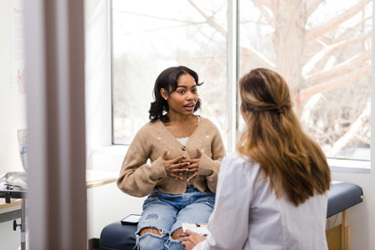6 Things Rare Disease Patients Want Sponsors To Know About Clinical Trials
By Sabina Kineen, rare disease patient, caregiver, and advocate, Clinical Trials For All

For some patients, clinical trials can be a viable option for receiving breakthrough treatments before they are commercially available — and for rare disease patients in particular, research as care can mean the difference between some treatment or no treatment at all. Unfortunately, many people never get the opportunity to hear about clinical trial options, and many others who do discover trials — whether on their own or all-too-rarely through their physician — still may not know how best to advocate for themselves. Given my personal journey as both a rare disease caregiver and patient, I hope to shine a light both on the importance of clinical trial education for patients and caregivers and on the specific ways sponsors can support them.
Living With Fabry Disease — As Caregiver And A Patient
My father became the first in our family to be diagnosed with Fabry disease. In 1984, during a routine employment physical, my father presented with proteinuria, even though his other vitals were healthy. Eager and curious, his doctor ordered a series of tests and soon diagnosed my father with Fabry disease.
At that time, the medical community had hardly any information about Fabry disease — just a small paragraph in a medical journal. However, as the doctor ran the tests and asked my father targeted questions, all the things he said “yes” to — burning sensation in his hands and feet, problems with heat and cold, and family members who died young — pointed to this rare diagnosis.
After his diagnosis, we went through genetic testing. Fabry disease is X linked and, at that time, they were calling it X link recessive. My brothers were not impacted, but my three sisters and I were. The medical experts then believed that women didn’t have symptoms. They explained the severity of the disease and how it would impact male patients. One genetic counselor went as far as to advise us never to have children.
For many years, we focused on my dad. I worked desperately to find a clinical trial that could help him, but there were simply none available or none he qualified for — a very real problem for people struggling with rare diseases and their caregivers. Some of the main challenges include:
- Rare disease trials are very difficult to find.
- Most doctors aren’t aware of rare disease trials.
- The inclusion/exclusion criteria for these trials are extremely narrow.
- Once you do find a trial, it may be a flight — or sometimes even a country — away.
In 2003, while two companies vied for FDA approval of a drug for Fabry disease, my sister and I spoke at their FDA hearings. That effort finally enabled him to enroll in a trial for one of the drugs. This began a seven-year period of my sister and me helping my dad travel from Pennsylvania to New York. It took a two-hour bus ride. As a newlywed and new mother, it was really hard navigating the role of caretaker, mom, and employee — but I’m so glad that I (we) did it, as it extended my father’s life. And it helped me realize I needed to be healthy and be there for my kids.
During the early 2000s, the medical community began to recognize that women who carried the Fabry disease gene did indeed have symptoms. I had been suffering with problems my entire life, but my doctors had always written it off as other things: It’s just your hormones. It’s growing pains. It’s _______. You get the idea. Women, unfortunately, often have our pain and medical issues downplayed and overlooked by medical professionals.
The recognition of the medical community coincided with my personal recognition that I needed to seek support for my disease. So, I began looking online. After much searching, I found ClinicalTrials.gov. Efforts have been made to improve it recently, but in the early 2000s, it was certainly not patient friendly. Then and now, most doctors are not aware of rare disease trials, so unless you are seeing a physician at a dedicated center of excellence conducting a trial, you have to advocate for yourself.
In 2006, I found a Fabry disease trial enrolling women — which was exceptionally rare — run by a small biotech with a trial site located in Georgia. I enrolled in the trial, and that meant a lot of sacrifices since I lived in Pennsylvania. People have often asked why I went through with it, given all the practical challenges to participation. The biggest reason? I had the ability to do so — something that not all patients have. I had a strong, supportive family. I could give up my full-time job because my husband could financially sustain us. I had friends who could watch my kids. I had siblings who could support me in my role as primary caregiver for my father. Financially, practically, and emotionally, I had the ability to say yes to this research program.
My trial started, and there was a total of 23 participants. I became the second person to receive the new drug and one of only nine women. I started as a Phase 2 trial participant and stayed through several extensions for a total of 12 years before the FDA finally approved the drug.
What Rare Disease Patients Want Sponsors To Know
One of the things I’m most grateful for during the course of my clinical trial experience is the opportunity I had to partner with the sponsor. I learned what goes into trial design and its execution, and I went from being a trial participant to speaking at late-cycle meetings to share the patient voice. And of course, I also had the experience of serving as a caregiver through my father’s clinical trial experience, and that also informed the insights I offered.
When I first started along the clinical trial path, I had no idea what an IRB was. I had no idea what it meant to sign your name to a 30-page trial protocol. Through my journey and my father’s, I have seen advances in patient and caregiver experience, though I continue to see areas for improvement.
Early on, the small biotech sponsor learned it was a huge waste of time to not have a patient help write the trial protocol. Now, they invite patients to help write the protocol before it’s submitted. I learned what I could ask for; they learned what they can do to help.
Now, I’m sharing my key takeaways for sponsors running clinical trials today:
- Understand that every single trial participant is different. Get to know what each of them needs in their life to make their participation as seamless as possible. Ask them what their burden is and what you can do to lift it. For example:
- Finances — Sponsors often pay for flights and hotel rooms up front, but many trial participants have to be reimbursed for meals. That precludes people with less financial means from being able to participate, reducing your trial equity and diversity. Provide patients with a card they can use for food and incidental expenses.
- Transportation — Make sure you have a concierge service available for all levels of patient transportation — not just for flights, but also for transport to and from the airport, to and from the hotel, and to the trial site.
- Childcare — Whether on-site or paid for to enable patient travel, this is essential for many.
- Access and choice — Not everyone can travel to a research site, but on the other hand not everyone is comfortable having a mobile research unit pull up in front of their house or apartment building for all the neighbors to see. Talk to your patient and understand what works best for them.
- Understand the disease and its limitations on your patient participants. For example, as a Phase 2 participant, I endured a battery of tests — yet as a patient with Fabry disease, one of the main issues I struggle with is fatigue, and fatigue sometimes leads to a pain crisis. This made it very difficult to adhere to the back-to-back timing of the tests.
At one point, I experienced a crisis-induced migraine yet still had to undergo an MRI. In horrible pain, I then drove myself back to my hotel, barely got down the hallway to my room, and collapsed on the floor. I finally asked my investigator team for help, relaying that I couldn’t do this on my own anymore. The sponsor helpful Once I realized I was within my rights to express my concerns, the sponsor offered help. From that point on, the sponsor covered travel expenses for a caregiver to come along. They also tried to schedule the different tests and procedures in a way that allowed time for rest/recovery. Knowledge of the implications of my condition on the front end could have made my experience much better from day one.
- Save patient travel time and study cost by incorporating decentralized elements. Consider using remote data collection, mobile research units, and/or patients’ local lab facilities for things like patient histories, blood draws, etc. Not everyone can take multiple days off work and pay for childcare to travel frequently to an on-site study location for these checkpoint items.
- Communicate trial information with community groups. With the help of patient organizations, sponsors have made great strides in both patient experience and, even before that, in educating the public that there are even trials going on. This has been facilitated by the realities of modern communication; back when my father and I were first diagnosed, not only was there no social media but people didn’t even have email yet! Sponsors are now partnering with trusted communities online to get the word out.
If you have a big trial coming up for a more common disease, like diabetes or cancer, you can still go to these trusted communities — houses of faith, the local senior center, or a local rec center — to get the word out.
- Improve trial diversity by working with community leaders and partnering with former trial participants. Those from underserved communities who might not otherwise discuss medical issues with anyone will feel more comfortable seeing someone who looks like them and is in their season of life who has been through it. That’s where more trust can be built to help improve diverse enrollment.
- Aim to alleviate both patient and caregiver burden. For patients who have someone supporting them throughout the course of your clinical trial, the time, energy, and cost affects both lives and may need to be uniquely addressed for each person — especially if they don’t live together.
It has been wonderful to see how the clinical trial industry has evolved to be more patient-centric since the mid-’80s. There is always more work to be done to optimize research for the patients, and I’m grateful to have the opportunity to share insights from both a patient and caregiver perspective. It is through patient/caregiver and sponsor partnership that the future of the clinical trial space will continue to improve for all involved.
About The Author:
Sabina Kineen is a rare disease patient, caregiver, and advocate who prioritizes collaborating and building bridges. She is also a Clinical Trials For All partner.
